#iberia
Text
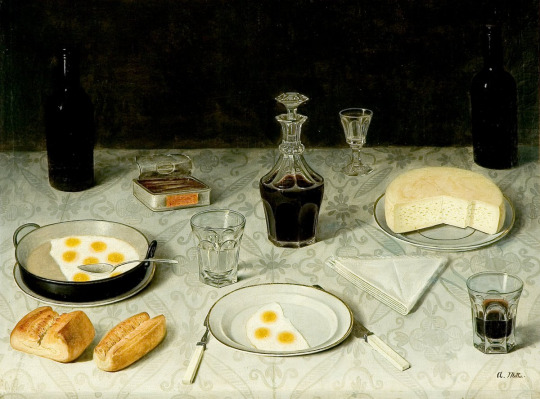
Vicente Mallio (Portuguese, 1832-1892)
Still life, ca.1801-1900
#you can now buy me a coffee no pressure#Vicente Mallio#portuguese#1800s#still life#art#fine art#european art#classical art#europe#european#oil painting#fine arts#europa#mediterranean#portugal#iberia#iberian peninsula#southern europe#buy me a coffee
3K notes
·
View notes
Text
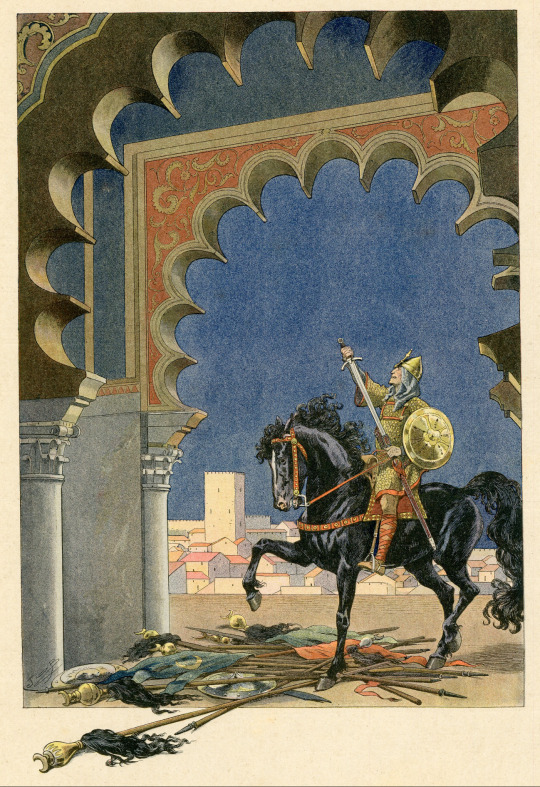
#jacques onfroy de bréville#job#art#illustration#spain#reconquista#el cid#el cid campeador#knights#knight#crusade#crusades#crusader#spanish#hispania#iberia#iberian peninsula#history#medieval#middle ages#chivalry#sword#europe#european#christianity#christian#christendom#mediaeval#reconquest#españa
160 notes
·
View notes
Photo

Iberian Peninsula under Germanic Rule in 500 AD.
177 notes
·
View notes
Text
hello arknights fans i have a puzzle that needs solving. so whisperain’s new skin, it’s wonderful & we all bought it, correct?

looking in the background you can clearly see who the figures in the stained glass windows are supposed to be. they’re other iberians, specifically ones who have connections with the church of the deep, but aren’t themselves seaborne, abyssal hunters, or clothed members of the church (you can make arguments about amaia but that’s for another post).


we have irene, lumen, & amaia on the left side. then thorns & elysium on the right. my question is: can anyone tell who this third figure on the right is?

they have very distinctive bangs in their face, they’re holding a book (possibly supposed to be religious text?), what looks like a curved staff, and might have long hair to the side. WHO IS THIS??? i’ve done comparisons with every potentially relevant character i can think of (quintus, aulus, cicero, dario, carmen, literally every playable iberian) & i am stumped. no one fits as neatly as any of the other stained glass figures do. the closest i’ve gotten is maybe skalter? kal'tsit?? WEEDY??? HELP
54 notes
·
View notes
Text
Ancient Necklace from Georgia (South Caucasus), c. 100-200 CE: this necklace is almost 2,000 years old; it includes an amulet case with a ram's head carved in amethyst, a garnet-studded perfume vial, and a chain woven from gold
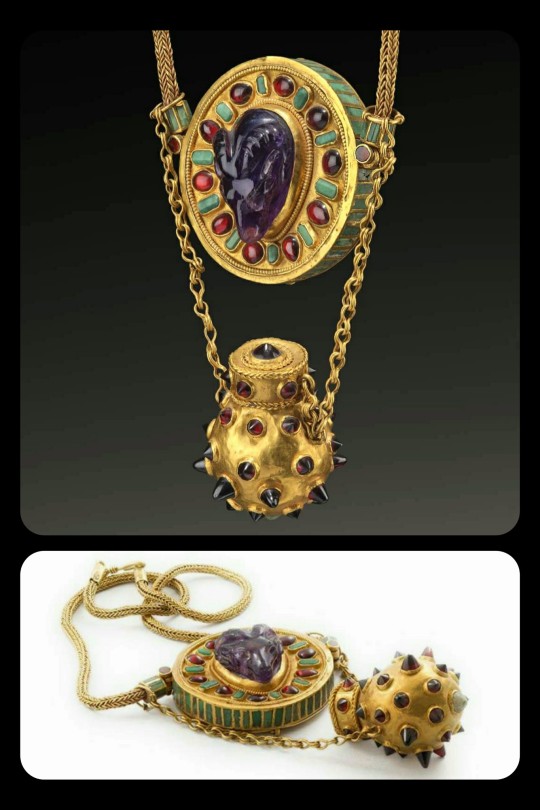
This necklace features two pendants:
The uppermost pendant is a hollow, puck-shaped medallion with a removable lid that opens from the front, allowing the pendant to be used as a container/locket (possibly for a textual amulet or similar item); the lid is decorated with an amethyst relief of a ram's head, along with a ring of alternating turquoise and garnet stones. Turquoise tiles can also be seen running along the outer edge of the amulet case, and a chain is attached to each side, with a second pendant hanging below.
The second pendant is a hollow, pear-shaped container used for storing perfume or incense. The body of this second vessel (and its cap) is decorated with a series of garnet "spikes."
Both pendants are made of gold, as is the primary chain, which is crafted from a series of gold strands that have been twisted into a thick wicker-work pattern.
The necklace was found in the ancient necropolis of Armaziskhevi (located near Mtskheta, Georgia) which is a site that was once used by members of the local aristocracy, including the provincial governors (Pitiakhsh) and high-ranking nobles (Eristavi) of Kartli/Iberia, in what is now the Republic of Georgia.
I know I've mentioned this in some of my previous posts, but just for reference, here is a map showing the location of modern-day Georgia:

Sources & More Info:
Georgian National Museum: Necklace with Medallion & Perfume Vial
Caucasus Travel Guide: Archive of Georgian Artifacts
Georgian National Museum: Archaeology of the Roman Period in Georgia (essay & catalog)
#archaeology#history#artifact#ancient history#jewelry#art#georgia#sakartvelo#iberia#ancient art#gold#caucasus#anthropology#amethyst#turqouise#crafting#necklace#amulet
258 notes
·
View notes
Photo

Iberian Devil Mask
154 notes
·
View notes
Text

This winged feline (500–400 B.C.) originally served as the front leg of a wooden chair or throne. Felines were popular in the art of many Mediterranean and Near Eastern cultures. Certain stylistic features of this piece, as well as the manner in which it was made from separate pieces of bronze joined together, suggest that this work was created in Spain, specifically in the kingdom of Tartessos. The form of the feline's brow is a Tartessian characteristic, as is the triangle design in the creature's ear. Image by Getty Museum.
Learn more / Daha fazlası
Tartessos https://www.archaeologs.com/w/tartessos/
#archaeologs#archaeology#archaeological#dictionary#history#art#mediterranean#culture#tartessos#spain#iberia#tartesian#arkeoloji#tarih#sanat#ispanya
61 notes
·
View notes
Text
Time Travel Question 26: Ancient History XIV and Earlier
These Questions are the result of suggestions from the previous iteration.
This category may include suggestions made too late to fall into the correct grouping.
Please add new suggestions below if you have them for future consideration. All cultures and time periods welcome.
#Dʿmt#Time Travel#Ötzi#Bronze Age#Prehistory#The Bible#Siddhartha Gautama#Jesus of Nazareth#Religious History#Early Humans#Ötzi the Iceman#Textiles#History of Textiles#Ethiopian History#Slavic History#Lechitic Peoples#Lost Literature#The Tully Monster#Iberia#Spanish history#Ancient World
89 notes
·
View notes
Text
Madre Iberia

I adored @marraiwa's version ❤
#Hetalia#Aph iberia#Ancientalia#Mother iberia#Iberia#Rosas headcanons#hetalia axis powers#axis powers ヘタリア#axispowershetalia#axis powers hetalia
55 notes
·
View notes
Photo

the inquisitor
#arknights#irene#my art#illustration#artists on tumblr#art#digital artist#digital art#digital painting#arknights irene#arknights fanart#iberia#artknights#green#pink#lighthouse#2022
282 notes
·
View notes
Text
Sintra, Portuguese Riviera...

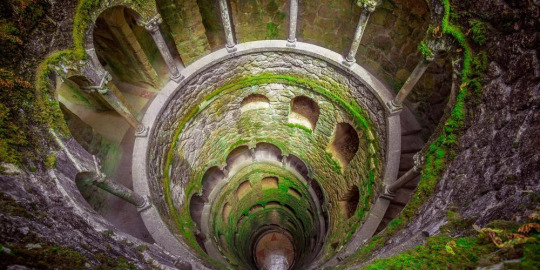
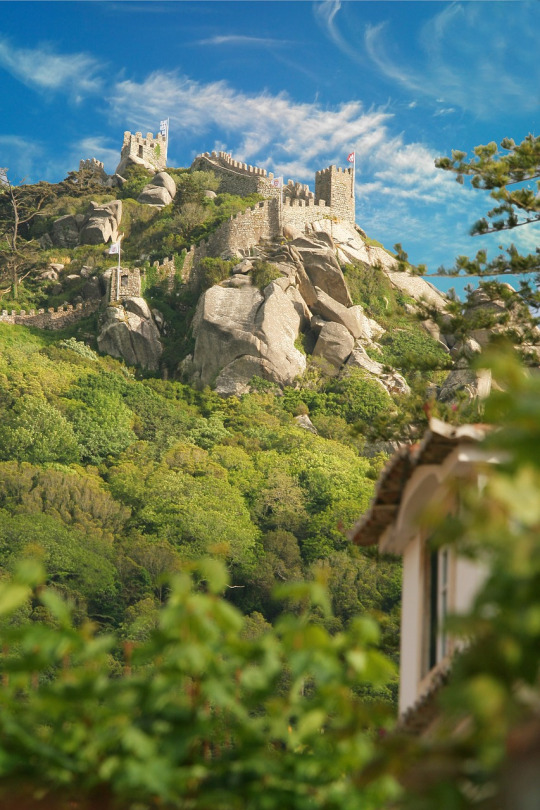
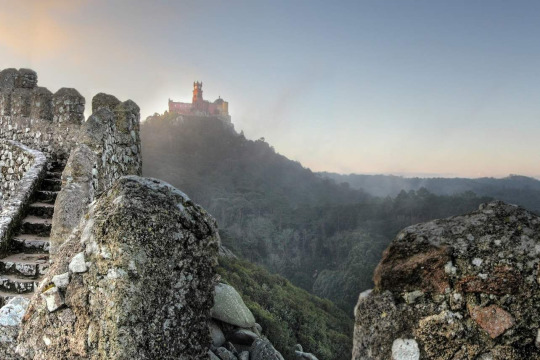






#nature#sintra#portugal#portuguese#hiking#travel#lisboa#moors#moorish#moorish architecture#iberia#europe#mountains#beach#atlantic ocean#fog#forest#gardens#cascais#enchantment#romanticism#pretty skies#summer#seasons#clouds#sunset#sunrise#aerial#coastline
17 notes
·
View notes
Photo
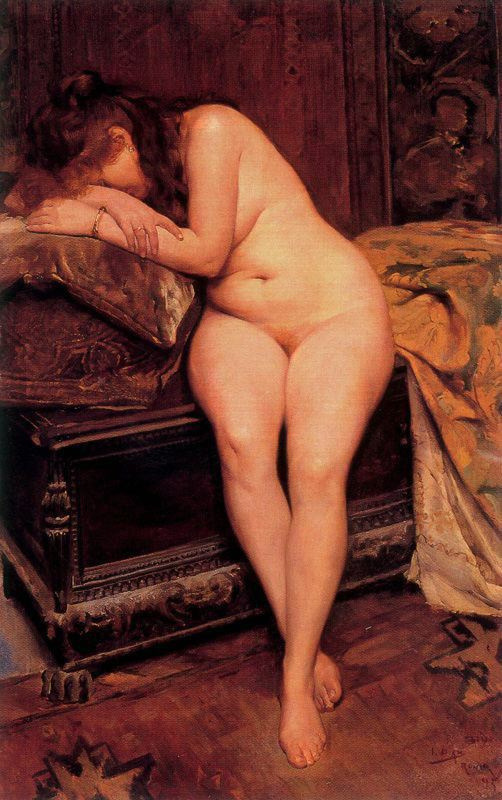
Ignacio Díaz de Olano, (Spanish, 1860-1937)
Unknown, 1895
#ignacio diaz de olano#art#fine art#female figure#victorian#female#european#woman#spanish art#Spanish Painter#spanish#spain#europe#iberia#mediterranean#western civilization#classical art#victorian era#victorian age
7K notes
·
View notes
Text

Mosaico de los Amores, Spain
#archaeology#mosaic#spain#art#jaén#andalucía#history#antiquity#cástulo#roman#ancient rome#ancient world#mosaics#europe#european#iberian peninsula#iberia#hispania#linares#floors#tiles#archaeologist#mosaico de los amores#mosaico#photography#photograph
400 notes
·
View notes
Photo

Mythical Beasts of the Iberian Peninsula.
by Neil Parkinson
594 notes
·
View notes
Text
just came across this map, i think it's quite interesting! it shows the identity sentiment of pertenance to a province / autonomous community by province, in brown-ish you have those provinces where the feeling is strongest, and in blue-ish those where the feeling is lowest.

the conclusions i can get while looking at it are
galicians, catalonians, basques and canarians are the ones with the highest regional identity. that should be no surprise, it makes a lot of sense as their cultures are the most distinct
all of castile has the lowest regional identity, which also kinda make sense i guess.
you can clearly see the two largest autonomic disputes in the country: guadalajara not feeling manchego (in fact i found this map on a tweet from someone from guadalajara demanding they secede from la mancha) and the old kingdom of león (león, zamora and salamanca) not feeling castilian.
andalusia is also quite interesting to me because you can clearly see the split between western and eastern andalusia. the west feels very andalusian, while the east not so much, especially almería.
the 'neutral' ones are the most interesting to me i think. i understand why madrid is like that, and i sorta get the balearic islands as well (people there tend to identify with their island and not the autonomy?), as well as murcia (people from cartagena would rather have a province of their own) but i have no clue about most of these
feel free to add your thoughts !!!
16 notes
·
View notes
Text
Islamic Architecture
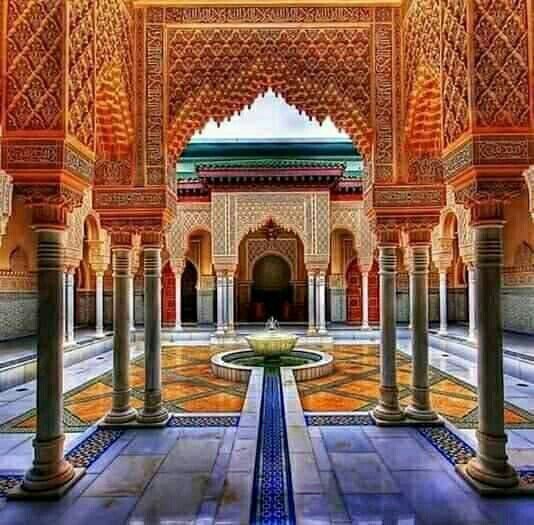
Unknown Photographer
#islamic#islam#muslim#muslims#architecture#muslim world#allah#prophet muhammad#prophet muhammed pbuh#design#geometry#geometric art#geometric design#spain#iberia#andalucía#andalusia#andalucia#morocco#europe
41 notes
·
View notes